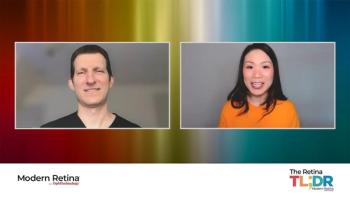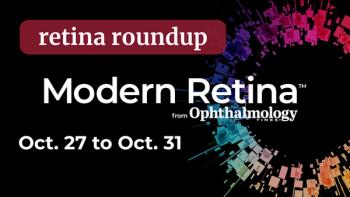
Potential risk factors for severe Spaceflight-Associated Neuro-Ocular Syndrome
The study helped identify predisposing factors for severe SANS in astronauts.
A recent report1 showed that 2 predisposing factors may have resulted in the development of spaceflight-associated neuro-ocular syndrome (SANS) of greater severity in 1 female astronaut than cases of SANS that developed in other astronauts, according to the lead author Tyson J. Brunstetter, OD, PhD, from the NASA Johnson Space Center, Houston.
SANS was first reported in 2011,2 and described as “anatomical changes to the eyes and brain during spaceflight as well as visual performance decrements in a subset of cases.”
SANS can develop during or immediately after spaceflight and is characterized by optic disc edema (ODE), chorioretinal folds, globe flattening, and/or hyperopic refractive shifts. As many as 15% to 20% of astronauts can develop what are considered clinically concerning levels of SANS during the course of or following lengthy spaceflights onboard the International Space Station.3 The patients are normally asymptomatic, but visual acuity (VA) changes have occurred.
The investigators reported that SANS “is likely driven by a response to the cephalad fluid shift that occurs during weightlessness and augmented by predisposing factors. Anatomical variability of the optic nerve head has been identified as a SANS risk factor,4 where a smaller optic cup volume may be less accommodating to the developing ODE. B-vitamin status, 1-carbon pathway biochemistry, and genetics have also been associated with SANS incidence,5,6 and thus, B-vitamin supplementation theoretically could be a countermeasure to prevent or mitigate SANS in at-risk astronauts.”
The investigators sought to gain an understanding of the potential predisposing factors associated with this severe case of SANS and possibly determine how to manage it. The astronaut underwent collection of blood samples and ocular testing before, during, and after the flight to the International Space Station.
During space travel, the astronauts on the mission underwent monitoring by
Compared with the preflight data, the results showed that the preflight cycloplegic refraction changed from −1.00 diopter bilaterally to +0.50 − 0.25 × 015 in the right eye and +1.00 diopter in the left eye 3 days after the space flight.
The preflight uncorrected DVA was 20/30 bilaterally, 20/16 or better by flight day 90, and 20/15 OU 3 days postflight. The inflight peripapillary total retinal thickness (TRT) reached the maximal value on flight days 84 and 126 (right eye, 401 μm preflight, 613 μm on flight day 84; left eye, 404 μm preflight, 636 μm on flight day 126) and then decreased.
The peripapillary choroidal folds peaked at 12.7 μm in the right eye on flight day 154 and 15.0 μm in the left eye on flight day126 and then decreased. The mean choroidal thickness increased throughout the mission.
The genetic analyses identified 4 of 4 risk alleles for SANS, ie, 2 minor alleles for MTRR 66 and 2 major alleles for SHMT1 1420.
The investigators commented that compared with other reports on SANS, the changes in this astronaut’s peripapillary total retinal thickness and in the hyperopic shift during a mission were greater. In addition, she was the only astronaut of the 4 on this mission in whom chorioretinal folds approaching the fovea developed.
The authors also pointed out that the B vitamin supplement and the decreased carbon dioxide level in the cabin might have been responsible for the improvement that occurred during the flight, but that still remains to be proven.
References:
Brunstetter TJ, Zwart SR, Brandt K, et al.
Severe spaceflight-associated neuro-ocular syndrome in an astronaut . JAMA Ophthalmol. Published online July 25, 2024;doi:10.1001/jamaophthalmol.2024.2385Mader TH, Gibson CR, Pass AF, et al. Optic disc edema, globe flattening, choroidal folds, and hyperopic shifts observed in astronauts after long-duration space flight. Ophthalmology. 2011;118:2058-2069. doi:
10.1016/j.ophtha.2011.06.021 National Aeronautics and Space Administration. Risk of spaceflight-associated neuro-ocular syndrome (SANS). Accessed February 20, 2024.
https://humanresearchroadmap.nasa.gov/evidence/reports/SANS.pdf Pardon LP, Greenwald SH, Ferguson CR, et al. Identification of factors associated with the development of optic disc edema during spaceflight. JAMA Ophthalmol. 2022;140:1193-1200. doi:
10.1001/jamaophthalmol.2022.4396 Zwart SR, Gibson CR, Mader TH, et al. Vision changes after spaceflight are related to alterations in folate- and vitamin B-12–dependent 1-carbon metabolism. J Nutr. 2012;142:427-431. doi:
10.3945/jn.111.154245 Zwart SR, Gregory JF, Zeisel SH, et al. Genotype, B-vitamin status, and androgens affect spaceflight-induced ophthalmic changes. FASEB J. 2016;30:141-148. doi:
10.1096/fj.15-278457
Newsletter
Keep your retina practice on the forefront—subscribe for expert analysis and emerging trends in retinal disease management.
















































